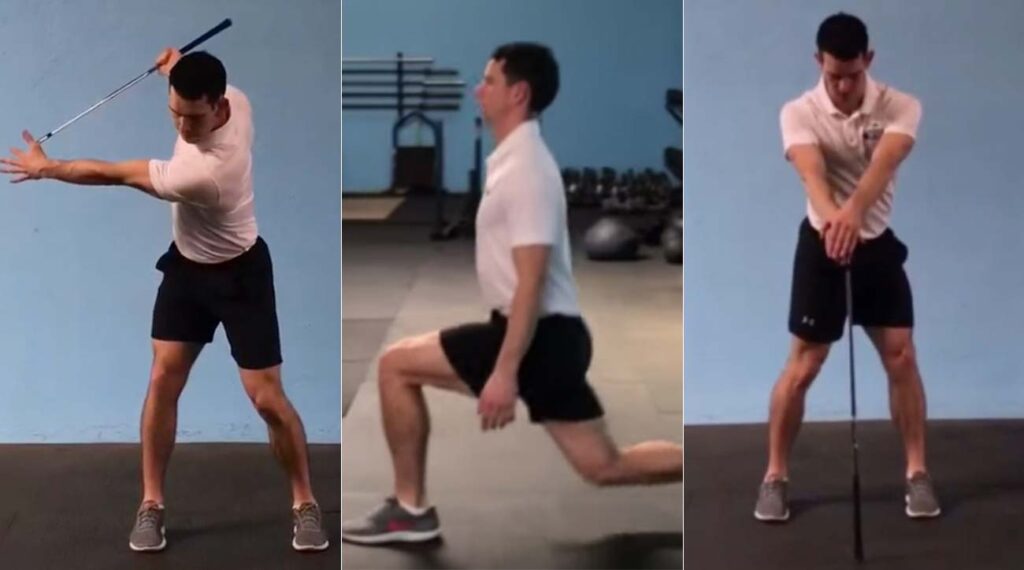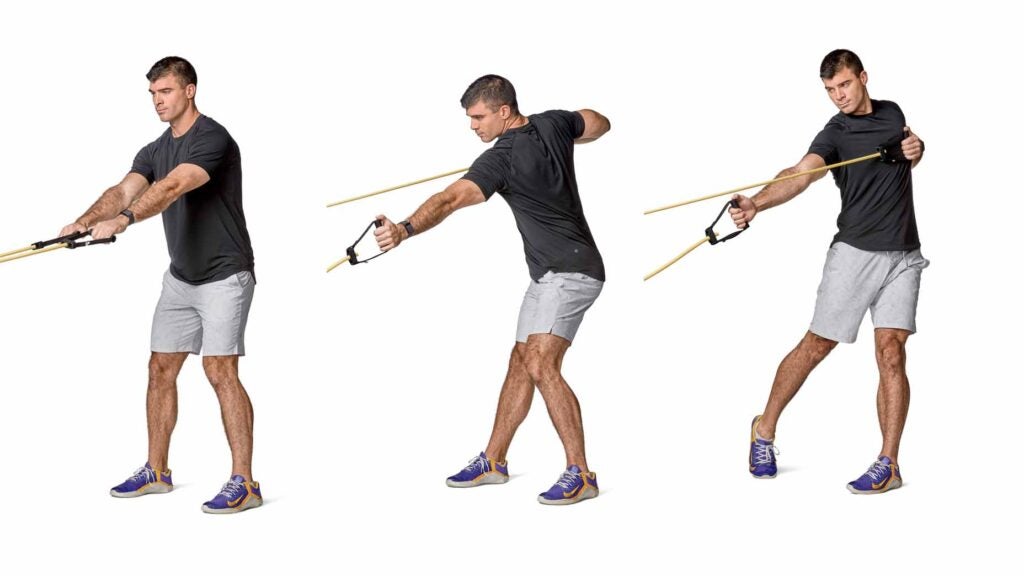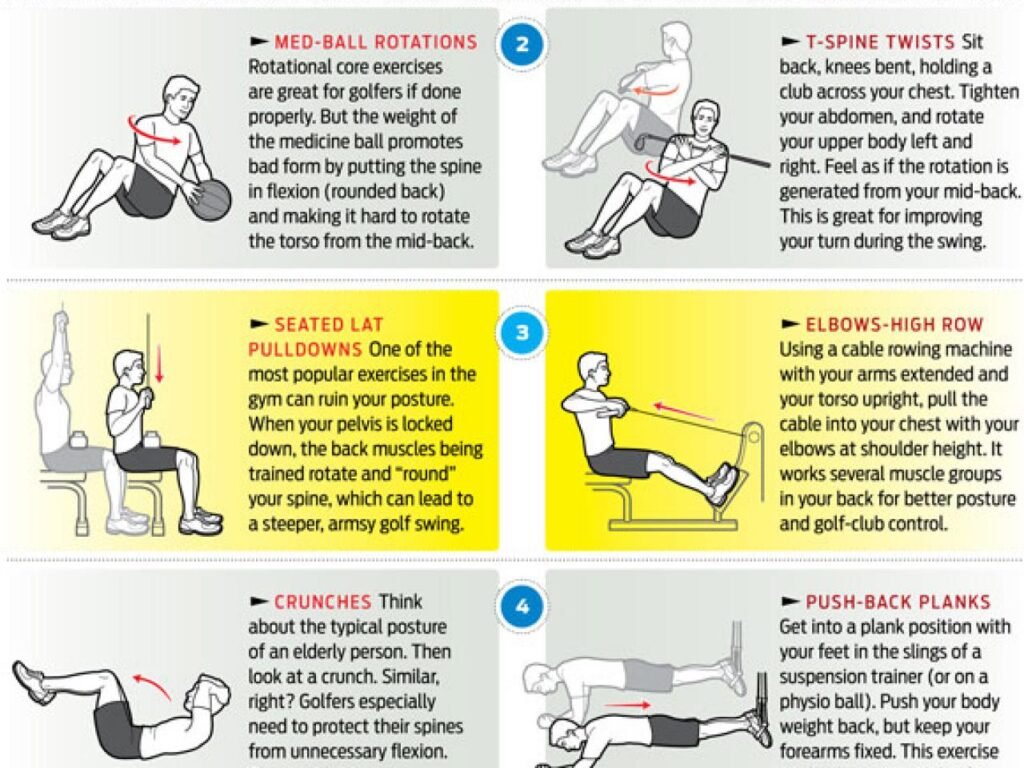If you’re an avid golfer seeking to improve your game, then focusing on your golf fitness is key. But with so many different exercise routines and fitness trends out there, it can be overwhelming to know where to start. Luckily, finding the best way to work on your golf fitness doesn’t have to be complicated. In this article, we’ll explore some practical tips and exercises that will help you enhance your strength, flexibility, and overall physical performance on the golf course. So grab your clubs and get ready to discover the most effective techniques to take your golf fitness to the next level!

Benefits of Golf Fitness
Golf fitness is a crucial aspect of improving your performance on the course. By incorporating fitness exercises and routines specific to golf, you can experience a range of benefits that will enhance your game and overall well-being.
Improved Swing Mechanics
One of the primary benefits of golf fitness is the improvement in swing mechanics. By increasing your strength, flexibility, and stability, you can achieve a more efficient and consistent swing. When your body is properly conditioned, it allows for better control of your movements, resulting in more accurate shots.
Increased Power and Distance
Another advantage of focusing on golf fitness is the increase in power and distance in your shots. By incorporating exercises that target the muscles used in the golf swing, such as the core, shoulders, and legs, you can develop more force and generate greater clubhead speed. This added power can translate to longer drives and more distance on your shots.
Enhanced Balance and Stability
Good balance and stability are essential elements of a successful golf swing. Through specific exercises that strengthen the core and improve overall body balance, you can achieve a more stable posture throughout your swing. This stability allows for better weight transfer and control, resulting in improved accuracy and consistency in your shots.
Reduced Risk of Injuries
Golf fitness can also help reduce the risk of injuries commonly associated with the sport. By working on strength, flexibility, and stability, you can improve your body’s ability to withstand the repetitive movements and stresses involved in the golf swing. A well-conditioned body is less prone to strains, sprains, and other golf-related injuries, helping you to stay on the course and enjoy the game pain-free.
Assessing Your Current Fitness Level
Before diving into a golf fitness routine, it’s important to assess your current fitness level. This assessment will help you identify areas of weakness or limitations that may be impacting your performance on the course. Here are some steps to consider when evaluating your fitness level for golf.
Consult with a Golf Fitness Professional
To get an accurate assessment of your fitness level, it’s beneficial to consult with a golf fitness professional. These experts have the knowledge and experience to evaluate your body’s capabilities and identify areas that can be improved to enhance your golf game. They can also provide personalized recommendations and exercises tailored to your specific needs.
Identify Weak Areas and Limitations
During the assessment process, it’s crucial to identify any weak areas or limitations that may be impacting your performance. This could include areas of muscle imbalances, flexibility restrictions, or previous injuries that need attention. By addressing these weak areas, you can improve your overall fitness and reduce the risk of potential injuries.
Consider Physical Condition and Overall Health
When assessing your fitness level, it’s essential to consider your physical condition and overall health. Factors such as age, medical history, and current fitness level can all influence your ability to engage in certain exercises or training techniques. It’s important to be honest with yourself and your healthcare provider to ensure a safe and effective fitness routine.
Determine Specific Goals
Setting specific goals is a crucial step in assessing your fitness level for golf. These goals could include improving flexibility, increasing strength, or enhancing balance and stability. By determining your goals, you can tailor your fitness routine accordingly and track your progress along the way.
Golf-Specific Exercises
Once you have assessed your fitness level and identified your goals, it’s time to incorporate golf-specific exercises into your fitness routine. These exercises target the muscles and movements used in the golf swing, helping you develop the strength, flexibility, and stability required for optimal performance on the course.
Flexibility Exercises
Flexibility is a key component of a good golf swing. By incorporating flexibility exercises into your routine, you can improve your range of motion and allow for a more fluid and powerful swing. Exercises such as shoulder stretches, hip rotations, and spinal twists can help increase flexibility in the areas most critical to the golf swing.
Strength Training
Strength training plays a vital role in golf fitness, as it helps develop the power and stability needed for a successful swing. Exercises that target the core, legs, and upper body, such as squats, lunges, and rows, can enhance your strength and contribute to a more powerful and controlled swing.
Core Stability Exercises
A strong and stable core is essential for a consistent and effective golf swing. Core stability exercises, including planks, Russian twists, and medicine ball rotations, can help strengthen your abdominal, back, and hip muscles. These exercises not only improve your balance and stability but also contribute to better control and transfer of energy during your swing.
Cardiovascular Conditioning
While golf may not be as physically demanding as other sports, cardiovascular conditioning is still beneficial for overall fitness and endurance on the course. Engaging in activities such as walking, cycling, or swimming can improve your cardiovascular health and stamina, allowing you to stay focused and perform at your best during long rounds of golf.
Warm-Up and Stretching Routine
Prior to hitting the links, it’s crucial to incorporate a warm-up and stretching routine into your pre-round preparation. This routine can help activate your muscles, improve flexibility, and prevent injuries. Here are some elements to consider when designing your warm-up and stretching routine for golf.
Dynamic Warm-Up Exercises
A dynamic warm-up is an effective way to prepare your body for the physical demands of golf. Dynamic exercises involve active movements that mimic the actions of the golf swing, such as arm circles, body rotations, and side lunges. These exercises help increase blood flow, warm up the muscles, and improve mobility before your round.
Targeted Stretching for Golf
Stretching is an essential component of any golf fitness routine, as it helps improve flexibility and prevent muscle imbalances. Targeted stretches for golf should focus on the muscles involved in the swing, such as the shoulders, hips, and back. Gentle stretches, such as shoulder rolls, hip stretches, and spinal twists, can help improve your range of motion and prepare your body for optimal performance.
Pre-Round Warm-Up Routine
In addition to a warm-up exercise and stretching routine, it’s beneficial to incorporate a pre-round warm-up routine specific to golf. This routine may include hitting a few practice shots at the driving range, performing swing drills, and focusing on your short game. By warming up your swing and mentally preparing for the round, you can start your game on the right foot and maintain a consistent and confident performance.

Proper Golf Swing Mechanics
To excel in golf, it’s crucial to develop proper swing mechanics. A technically sound swing not only improves accuracy and consistency but also helps optimize power and distance. Here are some key factors to consider when working on your golf swing mechanics.
Importance of Technique
Understanding and implementing proper swing technique is essential for a successful golf game. It’s crucial to work on the fundamentals, such as grip, posture, and alignment, to achieve consistency and accuracy in your shots. By focusing on technique, you can develop a solid foundation for your swing and build upon it as you progress.
Balance and Weight Transfer
Maintaining balance throughout the swing and executing proper weight transfer is vital for generating power and consistency. During the backswing and downswing, it’s crucial to distribute your weight correctly between your feet and utilize a smooth weight transfer to the front foot at impact. This proper weight transfer leads to optimal clubhead speed and control.
Swing Plane and Clubhead Speed
Understanding and maintaining the correct swing plane is key to a more efficient and powerful golf swing. The swing plane refers to the angle at which the club travels during the swing. By swinging along the correct plane, you can maximize your clubhead speed and increase the distance of your shots.
Efficient Body Rotation
A crucial element of a proper golf swing is efficient body rotation. The hips, torso, and shoulders should work together in a coordinated manner to generate power and maintain control. Strengthening the core and practicing rotational exercises can enhance your body’s ability to rotate efficiently, resulting in a more powerful and consistent swing.
Improving Power and Distance
For many golfers, increasing power and distance is a top priority. By incorporating specific exercises into your fitness routine, you can develop the strength, explosiveness, and sequencing required for longer shots. Here are some strategies to improve power and distance in your golf game.
Exercises for Generating Power
To generate power in your golf swing, it’s essential to engage in exercises that focus on explosive movements. Plyometric exercises, such as medicine ball throws and box jumps, can help train your muscles to generate more force and power. These exercises improve the fast-twitch muscle fibers used in the golf swing, resulting in increased clubhead speed and distance.
Explosive Rotational Movements
Explosive rotational movements are key to maximizing power and distance in your golf swing. Exercises such as medicine ball twists, rotational cable pulls, and kettlebell swings target the rotational muscles and help develop a more explosive swing. These movements enhance your ability to rotate effectively, leading to increased clubhead speed and greater distance.
Resistance Training for Increased Strength
Incorporating resistance training into your fitness routine can help improve the strength needed for a powerful golf swing. Exercises such as squats, deadlifts, and shoulder presses help develop the muscles used in the golf swing, such as the legs, hips, and upper body. By increasing your overall strength, you can generate more power and transfer that power efficiently throughout your swing.
Utilizing Proper Sequencing
Proper sequencing is essential for maximizing power in your golf swing. The sequence of movements, starting from the ground up and transferring energy through the body, is key to generating clubhead speed and distance. By practicing drills and exercises that emphasize proper sequencing, such as the “X-Factor” drill and the “Ground-Up” drill, you can develop a more powerful and efficient swing.

Enhancing Balance and Stability
Good balance and stability are fundamental to a successful golf swing. By incorporating exercises and training techniques that focus on balance and stability, you can improve your overall performance on the course. Here’s how you can enhance your balance and stability for better golfing.
Stability Exercises for Improved Balance
Integrating stability exercises into your golf fitness routine can significantly enhance your balance on the course. Exercises such as single-leg stands, balance board exercises, and stability ball lunges challenge your balance and proprioception, ultimately improving your stability during the golf swing. By incorporating these exercises, you can develop a more grounded and controlled swing.
Proprioceptive Training
Proprioceptive training plays a crucial role in enhancing balance and stability. It involves exercises that focus on your body’s awareness of its position in space. Incorporating balance and proprioception exercises, such as standing on one leg with your eyes closed or using balance discs, can improve your body’s ability to adjust and maintain balance during the swing.
Core Strengthening Exercises
Strengthening the core is essential for improving balance and stability in your golf swing. Exercises that target the abdominal and back muscles, such as planks, bird dogs, and Russian twists, help develop a strong and stable core. A strong core allows for better control of your body’s movements during the swing and contributes to a more consistent and stable striking of the ball.
Yoga and Pilates for Stability
Yoga and Pilates are excellent practices for enhancing balance and stability in golf. These disciplines focus on body alignment, core strength, and mind-body connection. By incorporating yoga or Pilates routines into your fitness regimen, you can improve your stability, flexibility, and overall body awareness, leading to a more controlled and balanced golf swing.
Preventing Injuries
Injury prevention should be a priority for any golfer looking to maintain longevity and enjoyment in the sport. By following proper warm-up and cooldown procedures, incorporating injury prevention exercises, and listening to your body, you can reduce the risk of common golf-related injuries. Here’s what you can do to prevent injuries on the course.
Identifying Common Golf Injuries
Recognizing common golf injuries is the first step in preventing them. Golfers often experience injuries such as golfer’s elbow, wrist strains, back pain, and knee issues. Understanding the causes and risk factors associated with these injuries can help you take proactive measures to prevent them.
Proper Warm-Up and Cooldown
A proper warm-up and cooldown routine is essential for injury prevention in golf. Before playing, it’s crucial to engage in dynamic warm-up exercises to increase blood flow, warm up the muscles, and prepare your body for the physical demands of the game. Afterward, a cooldown routine that includes gentle stretching and mobility exercises can help release tension, promote recovery, and reduce the risk of muscle soreness and injury.
Incorporating Injury Prevention Exercises
Incorporating injury prevention exercises into your fitness routine can significantly reduce the risk of golf-related injuries. These exercises may target areas prone to injury, such as the wrists, elbows, shoulders, and lower back. Strengthening exercises, mobility drills, and flexibility exercises can all help condition the muscles and joints used in the golf swing, reducing the likelihood of strains and overuse injuries.
Listening to Your Body
Perhaps one of the most important aspects of injury prevention is listening to your body. Pay attention to any discomfort, pain, or fatigue that may indicate an injury or overexertion. Rest and modify your training or playing schedule accordingly to avoid exacerbating any existing issues. By taking the time to listen to your body’s cues, you can prevent injuries and ensure a more enjoyable and sustainable golfing experience.

Training Schedule and Periodization
Developing a structured training plan and incorporating periodization techniques can significantly benefit your golf fitness journey. By balancing golf practice and fitness workouts, incorporating regular periods of rest and recovery, and setting long-term improvement goals, you can optimize your performance on and off the course. Here’s how you can create an effective training schedule and utilize periodization for long-term success.
Creating a Structured Training Plan
A structured training plan is essential for maintaining consistency and progress in your golf fitness routine. This plan should include specific workouts, practice sessions, and rest days, all designed to target your desired areas of improvement. By scheduling your training sessions and adhering to a plan, you can stay motivated and maintain a steady progression toward your goals.
Balancing Golf Practice and Fitness Workouts
Achieving a balance between golf practice and fitness workouts is crucial for optimal performance. While it’s essential to dedicate time to both aspects, it’s equally important to avoid overtraining and burnout. Striking a balance between golf practice and fitness workouts allows for skill development, physical conditioning, and ample recovery time.
Periodization for Long-Term Improvement
Periodization is a training technique that involves dividing your overall training plan into distinct periods or phases. Each phase has a specific focus and intensity level designed to target different aspects of your golf fitness. By incorporating periodization, you can systematically progress your training, prevent plateaus, and ensure long-term improvement in areas such as strength, flexibility, and power.
Rest and Recovery
Rest and recovery are integral parts of any training plan. It’s crucial to include regular rest days and periods of active recovery to allow your body to adapt and repair. Rest days give your muscles and joints time to recover from the physical demands of training and reduce the risk of overuse injuries. By prioritizing rest and recovery, you can maintain optimal physical and mental performance and avoid burnout.
Consulting with a Golf Fitness Professional
If you’re serious about improving your golf fitness and taking your game to the next level, consulting with a golf fitness professional can be highly advantageous. These experts are knowledgeable in the specific physical requirements of golf and can provide personalized guidance and training programs tailored to your needs. Here’s why seeking expert guidance is beneficial.
Seeking Expert Guidance
A golf fitness professional has specialized knowledge and experience in the field. They understand the physical demands of golf and can provide you with invaluable insights and guidance on how to improve your fitness and performance. By seeking expert guidance, you can ensure that your training is targeted, effective, and tailored to your specific goals.
Personalized Training Programs
One of the significant advantages of consulting with a golf fitness professional is the ability to receive personalized training programs. These programs are designed specifically for you, taking into account your current fitness level, goals, and any limitations or areas of weakness you may have. Personalized training programs allow for maximum effectiveness, as they address your individual needs and take you closer to achieving your desired results.
Evaluation and Progress Tracking
Working with a golf fitness professional allows for ongoing evaluation and progress tracking. These experts can assess your current fitness level, identify areas for improvement, and track your progress over time. Regular evaluations ensure that your training program is effective and can be modified as needed to continue progressing toward your goals.
Staying Motivated and Accountable
Another benefit of consulting with a golf fitness professional is the added motivation and accountability they provide. Having a trained professional guide and support you throughout your fitness journey can help keep you motivated, focused, and committed to your goals. Additionally, knowing that you have someone holding you accountable can significantly increase your chances of success in achieving your desired level of golf fitness.
In conclusion, incorporating golf fitness into your training regimen can have a positive impact on your game and overall well-being. By focusing on improved swing mechanics, increased power and distance, enhanced balance and stability, and reduced risk of injuries, you can optimize your performance on the course. Assessing your current fitness level, incorporating golf-specific exercises, warming up effectively, and paying attention to proper swing mechanics are essential components of a comprehensive golf fitness routine. Additionally, seeking the guidance of a golf fitness professional, adopting injury prevention strategies, and implementing a well-structured training plan with periodization techniques can further contribute to long-term success. By prioritizing your golf fitness and following the outlined strategies, you can enjoy a healthier, more enjoyable, and more successful golfing experience. So, lace up your golf shoes, grab your clubs, and start reaping the benefits of golf fitness today!






